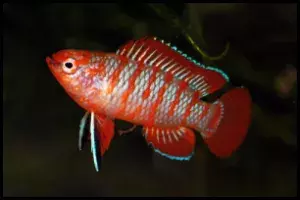
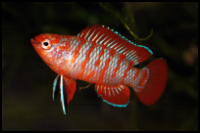
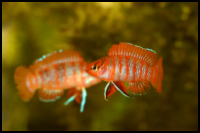
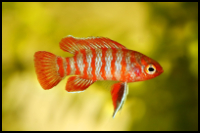
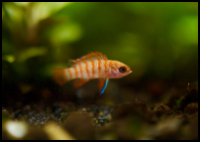

Quick Care Details (Table)
| Livestock Characteristics | Value |
|---|---|
| Care Level | Moderate |
| Temperament | Peaceful |
| Diet | Carnivore |
| Maximum Size | 1 Inches |
| Minimum Tank Size | 5 Gallons |
| Plant Safe | Yes |
| Temperature Range | 72-80F |
| PH Range | 6.5-7.5 |
| KH Range | 10-15 |
Species Specific Categories
Helpful Video
Care Details
Aquascape
- Provide a heavily planted aquarium with dense vegetation and floating plants.
- Include hiding spots such as caves, rocks, and driftwood to mimic their natural habitat.
- Utilize leaf litter or dried Indian Almond leaves to create a natural environment.
- Keep the aquarium well-maintained and clutter-free to give them space to swim.
Substrate
- Use a fine-grained substrate like sand or small gravel to prevent injury to the delicate barbels of the fish.
- Dark-colored substrates may help to bring out the scarlet colors of the Badis and reduce stress.
- Soil based substrates are acceptable especially if you would like to have plants.
Disease Prevention
- Quarantine new fish before introducing them to the main aquarium to prevent the spread of diseases.
- Maintain good water quality through regular water changes and filtration.
- Avoid overcrowding, as it can lead to stress and weakened immune systems.
- Properly acclimate new fish to minimize stress and improve their chances of staying healthy.
Filtration
- Use a gentle and adjustable filter, as this fish prefer slow-moving or still waters in the wild.
- Install a sponge or pre-filter on the intake to prevent the fish from getting trapped.
- Ensure the filter provides biological, mechanical, and chemical filtration for optimal water quality.
- Use of plants to help pull nitrates from the water could be useful in your fish tank.
Lighting
- Provide a subdued lighting setup to mimic dimly lit conditions similar to their natural habitat.
- Use adjustable LED lights to control the intensity and duration of lighting.
- Consider using a timer to maintain a consistent day-night cycle.
- You can use RGB multi colored lights. This will be beneficial to plants growth, but should not harm the fish.
Water Flow
- This fish prefer slow-moving or stagnant waters in their natural environment.
- Use a filter with adjustable flow settings to create a gentle water movement.
- Avoid strong water currents, as it may stress the fish and impede their swimming.
- Offer plants or hardscape to block waterflow at some spots in the tank for the fish to rest.
Hardiness
- This fish are generally hardy when kept in suitable conditions.
- They can tolerate a range of water parameters, but stable conditions are crucial for their well-being.
- Provide a proper diet and maintain good water quality to support their health and hardiness.
Temperament and Behavior
Behavior and Social Interaction
- This fish are generally peaceful but can display territorial behavior, especially during breeding.
- They prefer to stay near the bottom or middle of the aquarium, exploring their surroundings cautiously.
- They are shy and may retreat to hiding spots when stressed or frightened.
- Badis males may engage in a display of colorful patterns to attract females or establish dominance over other males.
- Scarlet Badis will change colors based on the level of its dominance. So if you have more than one male only one of them will show true red colors. All other males will lighten their colors mimicking female colors to avoid being harassed by to dominant male Scarlet Badis.
- These fish will perch and constantly search for food. They will eat from the bottom of the tank or in between hardscapes. So, if they don’t get the fish food from the initial drop into the aquarium it is still likely they will find it later.
Aggression
- Males can be territorial, especially during breeding, and may display aggression towards other males.
- Aggression is usually displayed through posturing and fin displays rather than physical harm.
- Care should be taken when keeping multiple males together in the same tank to prevent excessive aggression.
Breeding
- Breeding Dario species can be challenging, and a well-planted aquarium with hiding spots is essential for successful spawning.
- Males build bubble nests at the water surface to entice females to lay eggs.
- After spawning, the male guards the eggs and fry until they become free-swimming.
Compatibility
- Scarlet Badis are best kept in a species-specific setup or with peaceful, small, and non-aggressive tankmates.
- Avoid keeping them with larger or aggressive fish that may see them as prey or compete for resources.
- Suitable tank mates include nano peaceful fish like Rasboras, smaller Tetras, or peaceful dwarf shrimp.
- These fish have an extremely small profile, so keep in mind that medium sized fish might be able to eat the fish whole. If the fish can fit in its mouth, they will probably eat it.
- These fish should not be keep in a tank that is breeding shrimp fry. They will not harm adult shrimp but will eat the shrimp fry if they could catch it.
Activity Level
- Scarlet Badis are relatively inactive fish and spend a lot of their time resting or hiding among plants and decorations.
- They are slow swimmers and prefer leisurely movements around the aquarium.
Clean-up Crew
- Scarlet Badis do not have a significant role as part of a clean-up crew in the aquarium.
- They are not known for actively scavenging or eating algae like some other fish species.
Schooling or Shoaling Behavior
- Scarlet Badis are not strict schooling fish but can be observed in loose groups in their natural habitat.
- In the aquarium, they are more individualistic and do not require a large group for social interaction.
Diet and Nutrition
Dry Foods
- Generally Scarlet Badis will not eat dry foods. Some people claim they can train the fish to take dry foods but should not be fully relied on.
- If you do attempt to try dry foods be sure to use high-quality micro-pellets or granules designed for dwarf fish.
- Ensure the pellet size is appropriate for the small mouths of Scarlet Badis.
- Choose products with a good protein content and a mix of other essential nutrients.
Frozen Foods
- Frozen foods provide excellent nutrition and can be a staple in their diet.
- Offer frozen brine shrimp, daphnia, mosquito larvae, mysis shrimp or cyclops.
- Thaw the frozen food before feeding to prevent digestive issues.
Live Foods
- Live foods are highly beneficial and mimic the natural diet of Scarlet Badis.
- Feed them live brine shrimp, microworms, baby daphnia, or small insect larvae.
- Live foods are rich in nutrients and can stimulate natural hunting behaviors.
Vegetables
- Scarlet Badis are primarily carnivorous and do not have a high vegetable requirement.
- Some fish may nibble on the vegetables for variety, but it should not be a primary food source.
Algae
- Scarlet Badis do not rely on algae as a significant part of their diet.
Feeding Schedule
- Scarlet Badis have small stomachs, and it's essential not to overfeed them.
- Offer small portions of food 2-3 times a day.
- Adjust the amount and frequency based on their appetite and behavior, but be cautious not to leave excess food in the tank.
Tank Parameters
Tank Size
- Recommended tank size is 5 gallons (20 liters) or larger for a single pair of Scarlet Badis.
- Larger tanks provide more stable freshwater conditions and space for better aquascaping options.
- Keep in mind that Scarlet Badis are nano fish and don't require a massive tank.
Tank Length and Measurements
- For a 5-gallon tank, typical dimensions could be around 16 inches (40 cm) in length, 8 inches (20 cm) in width, and 10 inches (25 cm) in height.
- Tank measurements can vary based on the specific tank model and manufacturer.
The Species Maximum Size
- Scarlet Badis (Dario dario) reach a maximum size of about 0.8 to 1 inch (2 to 2.5 centimeters) in length for males.
- Females are slightly smaller than males.
Water Temperature
- Scarlet Badis prefer a tropical water temperature range of 72°F to 80°F (22°C to 27°C).
- Maintaining the water temperature within this range is important for their comfort and well-being.
pH (Acidity/Alkalinity)
- Recommended pH range for Scarlet Badis is slightly acidic to neutral, around 6.5 to 7.5.
- Keep the pH level stable within this range to avoid stress on the fish.
KH (Carbonate Hardness)
- The recommended carbonate hardness (KH) level is around 2 to 6 dKH (35.7 to 107.1 ppm).
- Carbonate hardness helps buffer the freshwaterwater against pH fluctuations.
GH (General Hardness)
- The general hardness (GH) level should be around 5 to 12 dGH (89.5 to 214.3 ppm).
- GH refers to the concentration of dissolved minerals in the freshwaterwater.
Nitrate (NO3) Levels
- Scarlet Badis are sensitive to high nitrate levels, which can negatively impact their health.
- Aim to keep nitrate levels below 20 ppm, and regular water changes can help achieve this.
History, Popularity, History and Species Variety Details
Scarlet Badis History and Popularity
Scarlet Badis, also known as Dario dario, is a dwarf freshwater fish native to the Brahmaputra River basin in India and Bangladesh. It was first scientifically described by Kottelat and Witte in 1999. The species was initially collected in Assam, India, and it gained attention among aquarists for its striking appearance and unique characteristics.
Since its introduction to the aquarium trade, Scarlet Badis has gained popularity among fish enthusiasts, particularly those interested in keeping nano unique fish species. Its stunning coloration and interesting behavior have made it a sought-after choice for aquarists looking to add a vibrant and eye-catching fish to their tanks.
The popularity of Scarlet Badis can be attributed to several factors. Firstly, its vibrant red body coloration, contrasting with iridescent blue or green markings, is truly striking. The males display intense colors during breeding and territorial displays, making them a captivating addition to any aquarium.
Secondly, Scarlet Badis has a dwarf size, typically growing up to around 1 inch (2.5 cm) in length. This makes it suitable for nano tanks and smaller aquarium setups, which have become increasingly popular among hobbyists due to their compact size and aesthetic appeal.
Additionally, the unique behaviors of Scarlet Badis have intrigued many aquarists. They are known for their slow and deliberate movements, spending much of their time exploring the bottom of the tank and occasionally darting towards prey. Observing their interactions and territorial displays can be a fascinating experience for aquarists.
Breeding The Badis Dario
- Select a Breeding Pair: Begin by identifying a suitable breeding pair of Scarlet Badis. Look for healthy and mature individuals that display vibrant colors and show signs of readiness to breed. It's best to introduce a male and female into a separate breeding tank.
- Set Up a Breeding Tank: Prepare a small breeding tank of around 5 to 10 gallons (19 to 38 liters). Use a gentle filter to provide water movement without creating strong currents. Add suitable hiding spots such as caves, PVC pipes, or small clay pots, where the female can lay her eggs and the male can establish a territory.
- Conditioning Period: Before breeding, condition the breeding pair by providing a varied and high-quality diet. Offer live or frozen foods rich in protein, such as brine shrimp, daphnia, and small insect larvae. Ensure the fish are in optimal health and condition for successful breeding.
- Adjust Water Parameters: Gradually adjust the water parameters in the breeding tank to mimic their natural habitat. Aim for a slightly acidic to neutral pH range of 6.0 to 7.5, temperature between 72°F and 79°F (22°C and 26°C), and soft to moderately hard freshwaterwater with a GH range of 4 to 10 degrees.
- Introduce the Breeding Pair: Introduce the conditioned male and female into the breeding tank simultaneously. Monitor their interactions to ensure they are compatible and not excessively aggressive towards each other. It may take some time for them to establish territories and initiate breeding behavior.
- Courtship and Spawning: The male will display courtship behavior, including vibrant coloration, flaring fins, and chasing the female. The female will respond by displaying receptive behavior, such as vertical positioning and quivering. The male will lead the female to the chosen nesting site, where the eggs will be laid and fertilized.
- Egg Care: After spawning, carefully remove the female from the breeding tank to prevent her from eating the eggs. The male will guard and tend to the eggs, fanning them to provide oxygen and prevent fungus growth. The eggs will typically hatch within 24 to 48 hours, depending on water temperature.
- Fry Care: Once the eggs hatch, the male will continue to guard the fry. Initially, they will survive on their yolk sacs, but after a few days, they will start swimming freely. At this point, you can provide infusoria, crushed flake food, or newly hatched brine shrimp as their primary food source. Maintain excellent freshwater quality and perform regular water changes to support the growth and health of the fry.
- Gradual Separation: As the fry grow, they will become more independent. Gradually separate them from the male and move them to a separate rearing tank or larger grow-out tank to allow for better growth and development.
Male gender vs Female gender (Sexual Dimorphism)
- Size: Males tend to be slightly larger than females, but the difference in size is often subtle.
- Coloration: Males have more vibrant and intense colors compared to females. Look for deep red or orange hues on the body and more prominent iridescent blue or green markings.
- Body Shape: Males may appear slightly more streamlined and elongated, while females have a slightly rounder body shape.
- Fin Shape and Color: Males often have longer and more elaborate fins, especially the dorsal and anal fins. The fin rays may have extensions or filaments. Their fins also display more intense coloration, with vivid patterns and shades.
- Vent Area: During the breeding season, males may exhibit more pronounced ventral markings or coloration around the vent area.
- Behavior: Males are generally more active and engage in courtship behaviors. They may display flared fins, vibrant colors, and chase or court the females.
- Egg Spot: Females may display a small, round egg spot (ovipositor) on their abdomen, which is absent in males. This spot is more prominent and visible when the female is ready to spawn.
- Breeding Tube: Males may develop a slightly more pointed or elongated breeding tube, located on the ventral side, which is used for transferring sperm during spawning.
- Key Note: Discerning the gender of the scarlet badis is extremely difficult. Even experts have a difficult time with this and most stores will not guarantee a specific gender. This is because the males can change their colors to match how females look. Their body shapes are also very similar. They do have differences, but they are extremely difficult to notice.
Frequently Asked Questions
What is the maximum size of Scarlet Badis?
Scarlet Badis typically reach a maximum size of about 1 inch (2.5 cm) in length.
Are Scarlet Badis aggressive?
Dario Dario are generally peaceful but can become territorial, especially during breeding. It is best to provide ample hiding spots and avoid keeping multiple males together in the same tank.
Can Scarlet Badis be kept in a community tank?
Badis Dario are best suited for a species-specific or single-species setup due to their shy nature. However, they can sometimes coexist peacefully with other small and peaceful fish species.
What should I feed Badis Dario?
Badis Dario are carnivorous and enjoy a diet consisting of live or live and frozen foods like brine shrimp, daphnia, and small insect larvae. It is difficult to get a Scarlet Badis to start eating dry foods. Training them to eat dry foods should be considered to be and expert level task.
How many Scarlet Badis can be kept in a tank?
They are best kept in small groups or pairs. For a 5-gallon (19-liter) tank can keep a pair. A small group of 4 to 6 individuals can be suitable for a 10 gallon tank. Larger tanks allow for more individuals and additional territories.
What are the ideal water parameters for Scarlet Badis?
They prefer slightly acidic to neutral freshwater with a pH range of 6.0 to 7.5. They thrive in temperatures between 72°F and 79°F (22°C and 26°C) and prefer moderate hardness levels.
Are Scarlet Badis prone to any specific diseases?
They are generally hardy fish, but like any other fish, they can be susceptible to common aquarium diseases if water conditions are poor or stress levels are high. Maintaining good water quality, providing a balanced diet, and minimizing stress can help prevent disease outbreaks.
Do Scarlet Badis require a heater in the aquarium?
They prefer warmer water temperatures within the range of 72°F to 79°F (22°C to 26°C). In most cases, a heater is necessary to maintain a stable and suitable temperature in the aquarium.
Can Scarlet Badis be bred in captivity?
Yes, Scarlet Badis can be bred in captivity. However, successful breeding can be challenging and requires specific conditions, including appropriate tank setup, suitable nesting sites, and proper conditioning of the breeding pair. The hardest part is to find a true female. Almost no store will guarantee the gender of a scarlet badis because "sneaker males" are extremely common. It is also possible for some female to transform into a full fledge male if there are no other dominate males in the tank with them.
Do Dario Dario change colors?
Yes, Dario Dario can display color changes based on their mood, health, or breeding condition. Males, in particular, may exhibit more intense and vibrant colors during courtship or territorial displays.
Are Scarlet Badis suitable for beginners?
Scarlet Badis can be suitable for beginners who are willing to research and meet their specific care requirements. However, they may pose some challenges due to their small size, specific water parameters, and potential breeding and diet complexities.
Can Scarlet Badis be kept with shrimp or snails?
Generally, they won’t eat small snails, but on rare occasion they have been seen to eat them. Small shrimps might end up as prey to a Scarlet Badis, but most adult shrimp around an inch won’t have problem sharing a tank with the Scarlet Badis.
Can Scarlet Badis change gender?
Yes, they are hermaphroditic and will change gender when lack of a male is present in the environment. So, if a group of females are in the tank one of them will become more dominant than the rest and develop male genitals. This transformation can only happen one way, once a scarlet badis has become a male it cannot turn back into a female, but it can lower its colors to look very similar to a female. This color change is used to avoid aggression from any other more dominant males.

